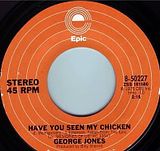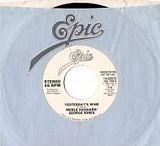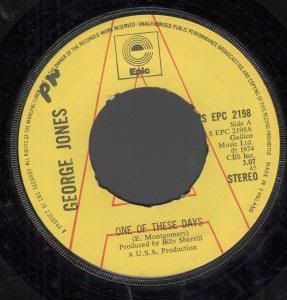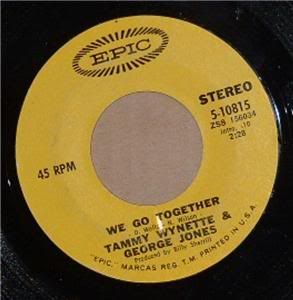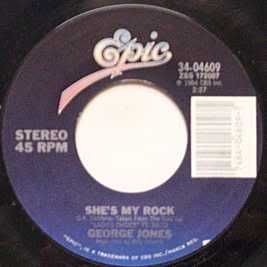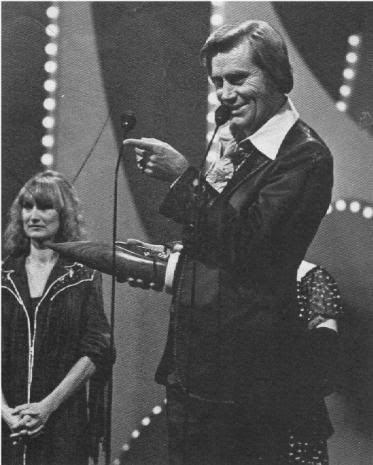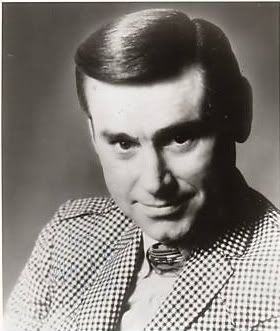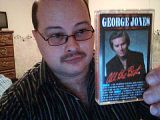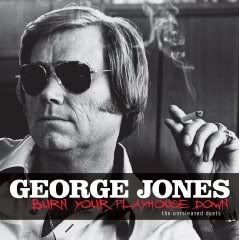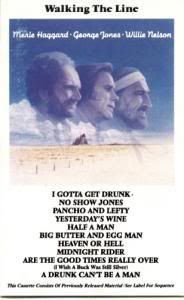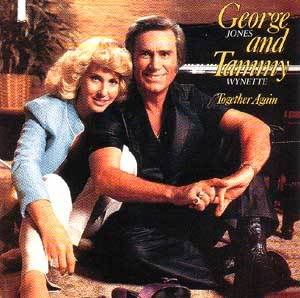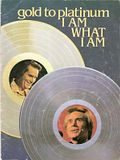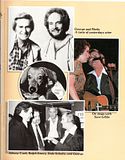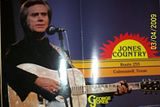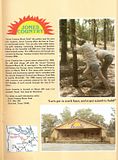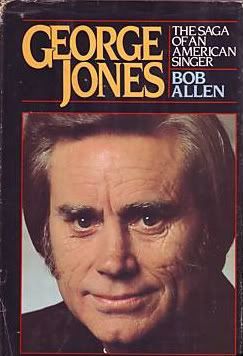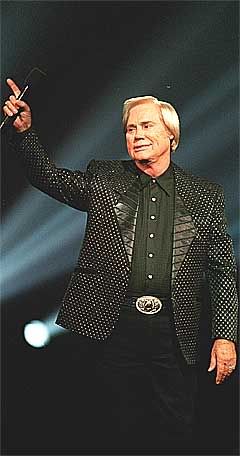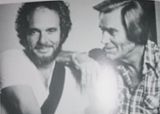 This box set collection from Time Life is chock full of George Jones goodness. Myself being a statistics and nostalgia nut I also enjoy the booklet that accompanies the collection. It contains a lot of wonderful pictures of George through the years. Some of the pictures were brand new to me so that was an added bonus. There isn't much to complain or criticize about in my opinion...not that I'm one to complain when it comes to the music of George Jones. Having said that I do wish that when they were putting this collection together they would have did a better song sequence on the CD's. This is a 3 CD set. Each CD contains 20 songs. On CD #1, for example, most of the earliest songs are found but track 18 from 1965, "Love Bug", is sandwiched between a hit song from 1969 and 1971. CD #2 kicks off with early '60s hits even though CD #1 left off with "A Good Year For the Roses", an early 1971 Top-5 hit.
This box set collection from Time Life is chock full of George Jones goodness. Myself being a statistics and nostalgia nut I also enjoy the booklet that accompanies the collection. It contains a lot of wonderful pictures of George through the years. Some of the pictures were brand new to me so that was an added bonus. There isn't much to complain or criticize about in my opinion...not that I'm one to complain when it comes to the music of George Jones. Having said that I do wish that when they were putting this collection together they would have did a better song sequence on the CD's. This is a 3 CD set. Each CD contains 20 songs. On CD #1, for example, most of the earliest songs are found but track 18 from 1965, "Love Bug", is sandwiched between a hit song from 1969 and 1971. CD #2 kicks off with early '60s hits even though CD #1 left off with "A Good Year For the Roses", an early 1971 Top-5 hit. George's 1978 duet with Johnny PayCheck, "Maybelline", is track #11 on CD #2 sandwiched between 1972's "A Picture of Me Without You" and 1973's "Once You've Had the Best". George's 1980 duet with Tammy Wynette, "Two Story House", is located on CD #2 as track 15. The songs before and after the 1980 hit are both from 1974. So it goes 1974, 1980, 1974...
This sort of thing may not annoy a mass market but it's annoying when songs leap from one era to the next and then back again on a box set. If this were a run of the mill "Greatest Hits" CD I wouldn't have an issue about song sequences but on a box set I wish the songs would be arranged in chronological order.
Ironically the box set doesn't include his 1999 hit, "Choices". Instead of selecting either that hit song from 1999 or "Cold Hard Truth", the compiler of the box set chose "When The Last Curtain Falls". The last song on CD #3 is "Tramp On Your Street" from 2001. As far as charts go, the compiler of the collection could have went with "The Man He Was" or George's duet with Garth Brooks, "Beer Run", to represent 2001 but instead chose "Tramp On Your Street". That song is great but it wasn't a single or a chart hit as the other two from 2001 were. There is no material on this collection from 1987, 1989, 1990, 1991, 1994, 1995, 1996, 1997, or 1998. The song, "I'm a One Woman Man", became the title of his 1989 album but technically it was recorded and released late in 1988. The two singles from 1989, "The King Is Gone and So Are You" and "Writing On the Wall", were not selected for this collection. In 1990 he had a duet hit with Randy Travis, "A Few Ole Country Boys". In 1991 he had a few chart hits with his MCA debut that are not spotlighted here: "Honky Tonk Myself To Death", "She Loved a Lot In Her Time", and "You Couldn't Get The Picture". The third song reached the Top-40 of the country charts.
 Since the material from this 1987 album/cassette wasn't spotlighted on the 2008 box set I think I'll spotlight it. I've wrote about this album before. Titled Too Wild Too Long it includes three singles: "The Bird", "The Old Man No One Loves", and "I'm a Survivor". The album also includes his version of "New Patches" which was a hit for Mel Tillis several years earlier. The title track is a hard-core country song, too. It's about a man who's lifestyle isn't suited for settling down with anyone and it refers to "not showing up" which makes listeners think of George's past reputation of not showing up at concerts. The lead-off song, "I'm a Survivor", fits George like a glove. It was issued as a single in late 1987 but surprisingly it stalled on the charts in the Top-60...marking the first time since the mid 1970's that a George Jones single didn't reach the Top-40 section of the country charts.
Since the material from this 1987 album/cassette wasn't spotlighted on the 2008 box set I think I'll spotlight it. I've wrote about this album before. Titled Too Wild Too Long it includes three singles: "The Bird", "The Old Man No One Loves", and "I'm a Survivor". The album also includes his version of "New Patches" which was a hit for Mel Tillis several years earlier. The title track is a hard-core country song, too. It's about a man who's lifestyle isn't suited for settling down with anyone and it refers to "not showing up" which makes listeners think of George's past reputation of not showing up at concerts. The lead-off song, "I'm a Survivor", fits George like a glove. It was issued as a single in late 1987 but surprisingly it stalled on the charts in the Top-60...marking the first time since the mid 1970's that a George Jones single didn't reach the Top-40 section of the country charts. Soon afterward, "The Old Man No One Loves" was made into a music video as video's had become one of the most important promotional tools because it gave a visual to a song's lyrics. Some artist's resisted making music videos, notably Conway Twitty and George Strait, because they feared that music videos over-exposed an artist visually and it created a scenario where a fan couldn't envision a song in his or her own mind if there's a music video indirectly stating how a song should be interpreted. George Jones had made a music video for "Who's Gonna Fill Their Shoes?" and it won a CMA Award for "Music Video of the Year" at the 1986 gala. "The Old Man No One Loves" didn't win such an award and it's so scarce that a lot of fans don't even remember a music video being made of the song. The song reached the Top-65 in 1988...charting even lower than "I'm a Survivor". This was the beginning of the slow radio decline that came into full effect in the early 1990's. The radio decline that was set in motion in the late 1980's eventually ended the strong airplay of not only George Jones but also Dolly Parton, Ronnie Milsap, Conway Twitty, Charlie Pride, Kenny Rogers, Vern Gosdin, Earl Thomas Conley, The Gatlin Brothers, Ricky Van Shelton, Ricky Skaggs, and several other popular artists who gained fame in the 1970's and 1980's.
The "New Country" movement that was beginning in the late '80s and in full-swing by 1992 had replaced all of those artists on the radio throughout the first half of the 1990's. The new artists were Clint Black, Garth Brooks, Alan Jackson, Travis Tritt, Vince Gill, Mark Chesnutt, Sawyer Brown, Diamond Rio, Trisha Yearwood, Martina McBride, and others. Vince Gill, actually, had been a fixture in Nashville for several years before becoming a recording star in the early 90's. He was most noted for being a harmony singer before gaining huge fame in 1991. Sawyer Brown had been having success since the late '80s but they became bigger stars in the 1990's during the youth-movement where country artists were being judged by the record labels and radio stations by not only how many albums they were selling but also by the age make-up of their fans. Established country acts whose fans were mostly 35 years old and older and barely sold half a million albums each release were tossed aside at country radio in favor of the younger/youth-attractive acts whose albums were selling a million or more copies each release. The new artists that I mentioned, with the exception of a couple, are no longer heard on the radio too much. Alan Jackson still cranks out the Top-10 songs and sometimes Martina McBride is high on the charts as well but the rest of them you can't say the same thing about. Although those artists are still being played on the radio they don't have the consistent Top-10 hits they once did with the exception of Alan Jackson.
 1983...wasn't that a wonderful year in George's career and personal life? You bet it was! 1983 is the year George married his current wife, Nancy. It's also the year he had four Top-10 hits...one of them reaching #1. Three of those Top-10 hits came from this album. It's Shine On. For those younger fans you may not know much about George's 1983-1984 output. The material he recorded during this time isn't well spotlighted. Basically nowadays what people do when they put together compilation albums on George is they often forget several of the hit songs from this time period. Sure, they include a song or two, but not an entire reflection of hits. Three Top-10 hits are on this album: "Shine On", "Tennessee Whiskey", and the #1 "I Always Get Lucky With You". A fourth Top-10, "C.C. Waterback", was a duet with Merle Haggard earlier in the year from their duet album from 1982, A Taste of Yesterday's Wine. 1983 is also the year George opened up his outdoor country music park, Jones Country. An album of the same name was released later in 1983 but not one song from that album was released as a single.
1983...wasn't that a wonderful year in George's career and personal life? You bet it was! 1983 is the year George married his current wife, Nancy. It's also the year he had four Top-10 hits...one of them reaching #1. Three of those Top-10 hits came from this album. It's Shine On. For those younger fans you may not know much about George's 1983-1984 output. The material he recorded during this time isn't well spotlighted. Basically nowadays what people do when they put together compilation albums on George is they often forget several of the hit songs from this time period. Sure, they include a song or two, but not an entire reflection of hits. Three Top-10 hits are on this album: "Shine On", "Tennessee Whiskey", and the #1 "I Always Get Lucky With You". A fourth Top-10, "C.C. Waterback", was a duet with Merle Haggard earlier in the year from their duet album from 1982, A Taste of Yesterday's Wine. 1983 is also the year George opened up his outdoor country music park, Jones Country. An album of the same name was released later in 1983 but not one song from that album was released as a single.Shine On in addition to the three hit songs includes the self-deprecating "Ol' George Stopped Drinking Today". The song isn't about George no longer drinking...it's actually about death being the only thing that stopped George from drinking. It's a clever and cute sing-a-long that closes the album. A not so cute song is "The Show's Almost Over", track nine. It's a sad ballad about a man who's living in hell as a result of chasing his dreams of being a famous singer.
Some country music purists may not like the overt pop flavor of "I Should've Called" but I love it. George tackles a song that several country artists have recorded but have never released as a single: "I'd Rather Have What We Had". John Conlee recorded it in 1981; Conway and Loretta recorded it as a duet in 1981; and in 1998 Lee Ann Womack recorded the song as a duet with Joe Diffie.







